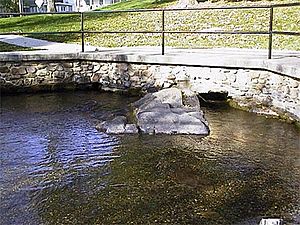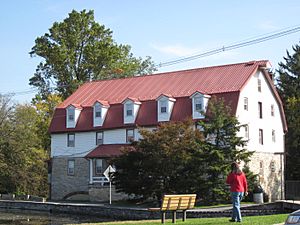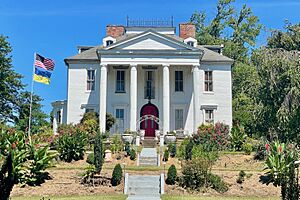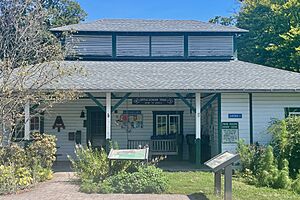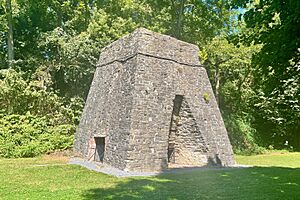Boiling Springs, Pennsylvania facts for kids
Quick facts for kids
Boiling Springs, Pennsylvania
|
|
|---|---|
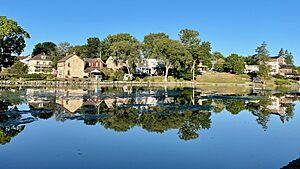
Children's Lake, in the center of Boiling Springs
|
|
| Nicknames:
Bubbletown
|
|
| Country | United States |
| State | Pennsylvania |
| County | Cumberland |
| Township | South Middleton |
| Area | |
| • Total | 2.48 sq mi (6.43 km2) |
| • Land | 2.47 sq mi (6.39 km2) |
| • Water | 0.01 sq mi (0.03 km2) |
| Elevation | 490 ft (150 m) |
| Population
(2020)
|
|
| • Total | 3,449 |
| • Density | 1,396.92/sq mi (539.43/km2) |
| Time zone | UTC-5 (Eastern (EST)) |
| • Summer (DST) | UTC-4 (EDT) |
| ZIP Code |
17007
|
| Area code(s) | 717 |
| FIPS code | 42-07472 |
Boiling Springs is a special town in Cumberland County, Pennsylvania. It's known for its unique natural springs. In 2020, about 3,449 people lived there. The town is part of the larger Harrisburg–Carlisle area.
Contents
Why is it Called Boiling Springs?
Boiling Springs gets its name from its amazing natural springs. These springs seem to "boil" because water bubbles up from underground. But the water isn't actually hot! It stays cool, around 55 degrees Fahrenheit, all year long.
How the Springs Work
The "boiling" effect happens because of the special rocks underground. About 200 million years ago, when the supercontinent Pangaea broke apart, huge cracks formed in the Earth. Hot, melted rock called magma filled these cracks. This magma cooled and hardened into strong, dark rocks called diabase dikes. These dikes are like underground walls that water cannot pass through.
The dikes form a "V" shape deep in the ground. When rain falls on nearby South Mountain, it soaks into the ground. Much of this water flows through soft limestone rock. But some water gets trapped by the hard diabase dikes. As the water gets closer to the tip of the "V" shape, it gets squeezed. This pressure pushes the water up to the surface, making it look like it's boiling!
One of the most famous springs is called "the Bubble." It's right behind the Boiling Springs Tavern. The local high school even named its mascot "The Bubblers" after this spring!
Children's Lake
Children's Lake is a beautiful 7-acre lake in the middle of Boiling Springs. It was created by building a small dam across a brook fed by the 30 natural springs, including "the Bubble." The lake is a home for many ducks, swans, and geese.
The lake has a long history. It was first created in the 1750s to power an iron production site. Later, in 1762, a grist mill was built on the lake's shore. This mill used the water power to grind flour and grain. Today, the old mill building has been turned into apartments.
On the east side of the lake, you can still see parts of the old iron works. There's also the Michael Ege Mansion, built in 1795. This historic house was home to the Ege family, who were important in the iron business.
The lake flows into Yellow Breeches Creek. This creek is famous for fly fishing because its limestone bedrock makes the water rich in minerals. These minerals help trout grow big and healthy. A special one-mile part of the creek, called "The Junction," is a popular spot for catch-and-release fishing all year.
Appalachian Trail Community
Boiling Springs is a special place for hikers! It's near the halfway point of the 2,200-mile-long Appalachian Trail. Because of this, Boiling Springs was named Pennsylvania's first "Appalachian Trail Community." This means the town is very welcoming and helpful to hikers.
The Appalachian Trail Conservancy has an office in Boiling Springs. It's the only office located right on the famous trail itself! Many hikers stop in Boiling Springs to pick up mail at the post office, which is very close to the trail. They can also get a shower at the local pool for a small fee. There are also places to stay, like bed and breakfasts or a nearby campground.
History of Boiling Springs
Europeans settled in Boiling Springs before 1737. The natural springs were used to power the Carlisle Iron Works in the 1750s. This iron works made important metal goods.
The Underground Railroad
Boiling Springs played a role in the Underground Railroad. This was a secret network that helped enslaved people find freedom. A man named Daniel Kaufman, who planned the village in 1845, was an "agent" for the Underground Railroad. From 1835 to 1847, he helped freedom seekers by providing food and a safe place to hide in his barn or nearby woods.
Boiling Springs is now part of the "Network to Freedom." This is a group of important places that were part of the Underground Railroad.
A Resort Town
In the late 1800s, Boiling Springs became a popular vacation spot. People would come to picnic and boat on Children's Lake. In 1895, trolley car lines were built from Carlisle and Harrisburg, making it easy for visitors to arrive. A park was built with fun attractions like a dance hall, picnic areas, and even a miniature steam railway and a merry-go-round! The trolleys ran until about 1930.
The historic parts of Boiling Springs were added to the National Register of Historic Places in 1984.
Fun Things to Do
Boiling Springs is still a great place for recreation and fun!
Outdoor Activities
- Fly Fishing: The Yellow Breeches Creek is famous for fly fishing. Many people come here to fish for trout.
- Children's Lake: You can enjoy boating or just watching the ducks and swans on the lake.
Events and Attractions
- Foundry Day: Every first Saturday in June, Boiling Springs hosts an arts and crafts show called Foundry Day. Artists and food vendors set up along Front Street next to Children's Lake.
- Anything Floats: On the 4th of July, the Carlisle Summerfair Festival holds an "Anything Floats" event. Teams build their own unique boats and race them across Children's Lake.
- Boiling Springs Pool: Built in 1927, this was the first public swimming pool in Cumberland County. It's still open to the public and has four pools and three waterslides.
Notable People
- J. E. Keeny: He was the president of Louisiana Tech University from 1908 to 1926 and grew up in Boiling Springs.
- Rob Moore: A Canadian politician who lived in Boiling Springs during his teenage years.
- David Spangler Kaufman: A politician and diplomat from Texas in the 1800s. A county and town in Texas are named after him.
| Historical population | |||
|---|---|---|---|
| Census | Pop. | %± | |
| 2000 | 2,769 | — | |
| 2010 | 3,225 | 16.5% | |
| 2020 | 3,449 | 6.9% | |
| Sources: | |||
See also
 In Spanish: Boiling Springs (Pensilvania) para niños
In Spanish: Boiling Springs (Pensilvania) para niños



